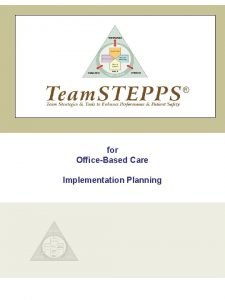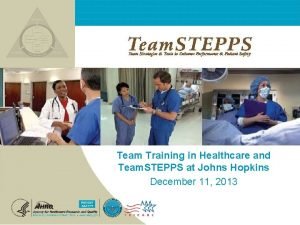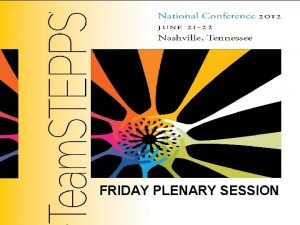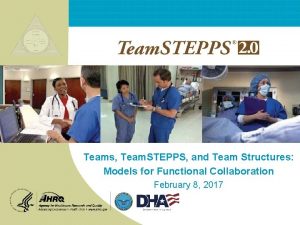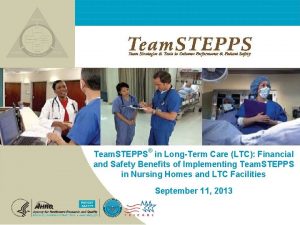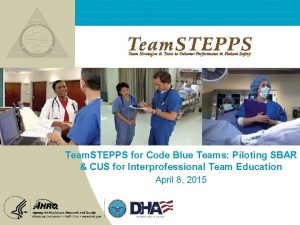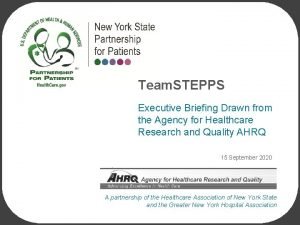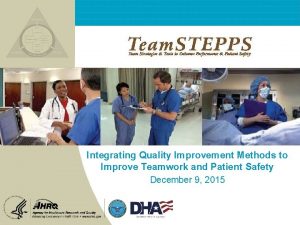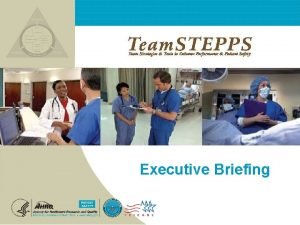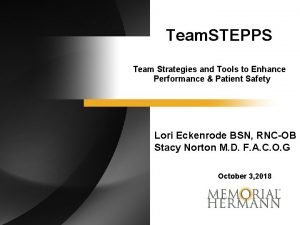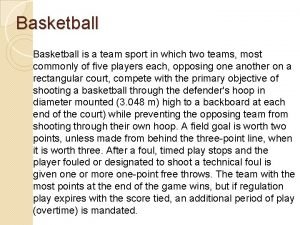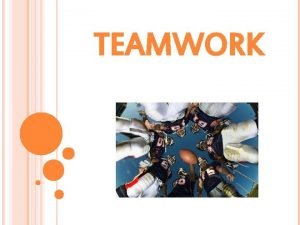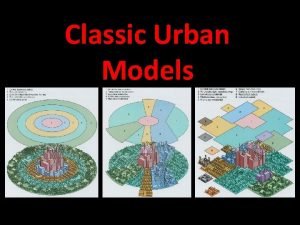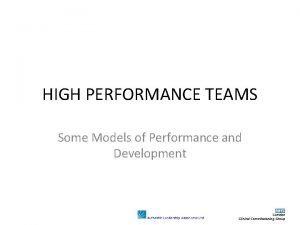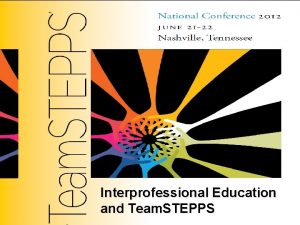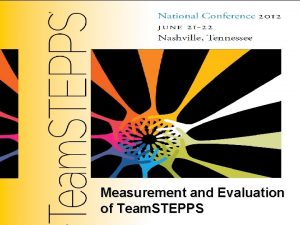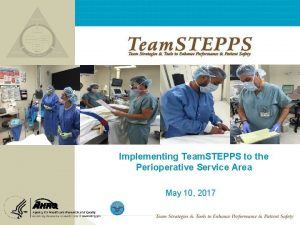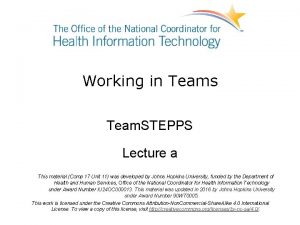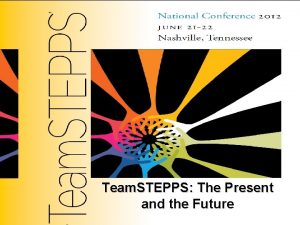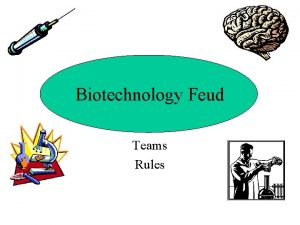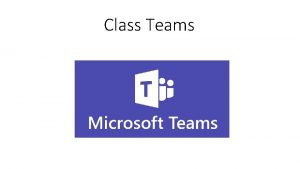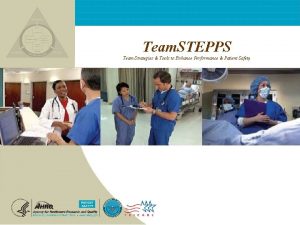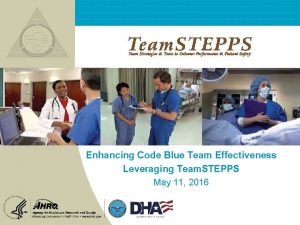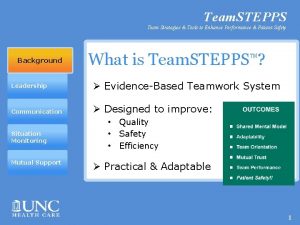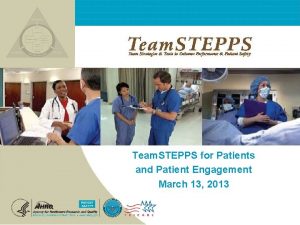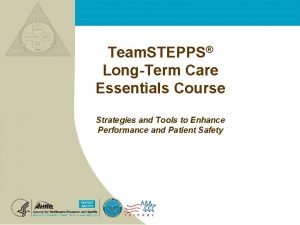Teams Team STEPPS and Team Structures Models for










































- Slides: 42

Teams, Team. STEPPS, and Team Structures: Models for Functional Collaboration February 8, 2017

Teams, Team. STEPPS, and Team Structures Rules of Engagement n Audio for the webinar can be accessed in two ways: 1. Through the phone (*Please mute your computer speakers) 2. Through your computer n A Q&A session will be held at the end of the presentation n Written questions are encouraged throughout the presentation and will be answered during the Q&A session n Slide 2 To submit a question, type it into the Chat Area and send it at any time during the presentation TEAMSTEPPS 05. 2

Teams, Team. STEPPS, and Team Structures Upcoming Team. STEPPS Events n Master Training Courses n Registration for courses through June 2017 now open n Registration opening on January 18 for courses in April. June 2017 n National Conference Slide 3 n June 14 -16, 2017 n Downtown Hilton, Cleveland, OH n Registration open and filling up fast! TEAMSTEPPS 05. 2

Teams, Team. STEPPS, and Team Structures Help Line (312) 422 -2609 Or email: AHRQTeam. STEPPS@aha. org Slide 4 TEAMSTEPPS 05. 2

Teams, Team. STEPPS, and Team Structures Today’s Presenter n William (Bill) Gordon, DMin, MDiv n Faculty, Department of Interprofessional Healthcare Studies n Rosalind Franklin University of Medicine and Science North Chicago, IL Slide 5 TEAMSTEPPS 05. 2

Teams, Team. STEPPS, and Team Structures No conflicts of interest I have no conflicts of interest to declare in relationship to this presentation Slide 6 TEAMSTEPPS 05. 2

Teams, Team. STEPPS, and Team Structures Objectives n Learn to analyze team structures by reviewing an organizational diagram, hypothesizing the assets and challenges to relationships, communication, and accountability n Differentiate between hierarchy, heterarchy, and holacracy as models of team organizational strategies n Evaluate these structures utilizing the Team. STEPPS domains of leadership, situation monitoring, mutual support, and communication n Consider possibilities of hybridized organizational models for task or time specific teams Slide 7 TEAMSTEPPS 05. 2

Teams, Team. STEPPS, and Team Structures Groups and Teams In a group, focus is on individual results n Slide 8 People are free to act independently, regardless of the behavior of others TEAMSTEPPS 05. 2 8

Teams, Team. STEPPS, and Team Structures In a team, success belongs to the whole, not to individuals n Slide 9 People are interdependently related, rather than being independent TEAMSTEPPS 05. 2

Teams, Team. STEPPS, and Team Structures Team. STEPPS Definition Two or more people who interact dynamically, interdependently, and adaptively toward a common and valued goal, have specific roles or functions, and have a time-limited membership Slide 10 TEAMSTEPPS 05. 2

Teams, Team. STEPPS, and Team Structures Two or more people who interact dynamically, interdependently, and adaptively toward a common and valued goal, have specific roles or functions, and have a time-limited membership Slide 11 TEAMSTEPPS 05. 2 This definition is largely behavioral, describing how members interact It does not, by definition, require a team to be interprofessional or even multidisciplinary

Teams, Team. STEPPS, and Team Structures How teams are structured or organized may affect: Slide 12 n How team members understand relationships to one another n How communication flows n Levels of personal accountability (based on decision -making strategies) TEAMSTEPPS 05. 2

Teams, Team. STEPPS, and Team Structures * Variations are possible, largely based on leadership styles and skills Slide 13 TEAMSTEPPS 05. 2

Teams, Team. STEPPS, and Team Structures 1. Relationships 2. Communication 3. Personal Accountability You are Here Slide 14 TEAMSTEPPS 05. 2

Teams, Team. STEPPS, and Team Structures The Vision is here (heroic model) You are here Slide 15 TEAMSTEPPS 05. 2

Teams, Team. STEPPS, and Team Structures Hierarchy • Characterized by “single node ascendancy” (Hero) • One person or group is in charge • In compliance driven hierarchies, power distribution is seen as “power-over” rather than “power-shared” • Election to leadership is often based factors such as longevity/seniority Slide 16 TEAMSTEPPS 05. 2

Teams, Team. STEPPS, and Team Structures Strengths of Hierarchies Efficiency and Familiarity n Very efficient model for the transfer of information to a group of limited size (i. e. small) n n Slide 17 Hierarchies can structure information flow Many organizational structures in our culture are built on hierarchies TEAMSTEPPS 05. 2

Teams, Team. STEPPS, and Team Structures Liabilities of Hierarchies Communication n Can be compromised by lack of trust and lack of access to decision-makers Disengagement n Lack of power at the edges may impact “buy-in” Poor accountability n Slide 18 As long as compliance-driven orders are received, workers can defer to having followed those instructions, and are not considered culpable TEAMSTEPPS 05. 2

Teams, Team. STEPPS, and Team Structures Where hierarchies are successful n Public safety n Military n Emergent situations where information flow is uni-directional n Teaching/education Hierarchies in and of themselves are not bad. Non-reflective use or abuse of power within hierarchies amplifies their liabilities Slide 19 TEAMSTEPPS 05. 2

Teams, Team. STEPPS, and Team Structures n Leadership: Potentially less- or non-collaborative, may not foster a relational model n Situation Monitoring: May be difficult to see the “big picture” as relationships are defined by position n Mutual Support: Depending on leadership, lateral access/communication may be difficult n Communication: Can be compromised by poor lateral communication and by filtering effects of passing information through layers of organization Slide 20 TEAMSTEPPS 05. 2

Teams, Team. STEPPS, and Team Structures 1. Relationships 2. Communication 3. Personal Accountability Slide 21 TEAMSTEPPS 05. 2

Teams, Team. STEPPS, and Team Structures Slide 22 TEAMSTEPPS 05. 2

Teams, Team. STEPPS, and Team Structures Heterarchy • Characterized by shared organizational structure that is web-like or hive-like • Generally considered to be a decentralized or shared power structure • Power transfers are fluid (happen easily and quickly) • Leadership may be based on information rather than education, position, longevity, title, etc. Slide 23 TEAMSTEPPS 05. 2

Teams, Team. STEPPS, and Team Structures Decisions and Communication Information flows non-symmetrically across the network n There is no formal “chain of command” Because of the shared power structure, edges are less likely to be constrained n Slide 24 Relationships tend to be non-linear TEAMSTEPPS 05. 2

Teams, Team. STEPPS, and Team Structures Strengths of Heterarchies Fluidity – The structure adaptable to challenges and changes Transparency – Because communication is transparent, trust is generated Accountability – Slide 25 Movement away from individual successes, elevation toward team accountability TEAMSTEPPS 05. 2

Teams, Team. STEPPS, and Team Structures Liabilities of Heterarchies Uncertainty n Unfamiliarity with structure leads to concern that “nobody is in charge” Informal channels of communication n Not all information permeates the entire structure n Information flow tends to follow a pattern of needs Maintenance n Slide 26 Requires reflective process among team members TEAMSTEPPS 05. 2

Teams, Team. STEPPS, and Team Structures n Leadership: Tends to be more fluid, based on information rather than titles, seniority, etc. n Situation Monitoring: Transparency is possible through open communication and access n Mutual Support: Vision is held by the whole, reinforcing need for enabling success of each team member. We all succeed or no one does. n Communication: Open, undefined by title, based on need, can be targeted to specific areas Slide 27 TEAMSTEPPS 05. 2

Teams, Team. STEPPS, and Team Structures 1. Relationships 2. Communication 3. Personal Accountability Slide 28 TEAMSTEPPS 05. 2

Teams, Team. STEPPS, and Team Structures Slide 29 TEAMSTEPPS 05. 2

Teams, Team. STEPPS, and Team Structures Holacracy • Requires team members be fully calibrated to the stated vision – Team members assume roles based on team need • Assignments are fluid based on need in alignment with vision – Team member contributions may vary greatly across function and task (Self-organizing, autopoietic) Slide 30 TEAMSTEPPS 05. 2

Teams, Team. STEPPS, and Team Structures Decisions and Communication More autonomy is given to individuals to make decisions – Can lead to high innovation – Requires a strong sense of team values Communication must be central to team functioning – Slide 31 Requires reflective ability and calls to accountability TEAMSTEPPS 05. 2

Teams, Team. STEPPS, and Team Structures Fluidity – Strengths of Holacracies Adaptive structure Valuing of Individuals – High importance placed on every member of the team – On-going opportunities for collaboration Connection – Increasing connection (and adaptation) of – structure to team vision Slide 32 TEAMSTEPPS 05. 2

Teams, Team. STEPPS, and Team Structures Liabilities of Holacracies Emergence n No hard rules, emerging organizational structure n May be more difficult to implement where established roles and responsibilities are more rigid/clearly defined Non-participation n Potential for passengers. Requires trust and development of organizational culture Tracking n Slide 33 Completion of tasks in a timely fashion may be harder to track TEAMSTEPPS 05. 2

Teams, Team. STEPPS, and Team Structures n Leadership: A lot of member autonomy and empowerment changes leadership model to “facilitator” n Situation Monitoring: Transparency allows view of larger organization (and possibly more experience across differentiated tasks) n Mutual Support: Early reports are this model engenders positive relations (i. e. “my community” rather than “my job”) n Communication: Can be challenging to be certain all who need to know are informed; may be more difficult to track tasks Slide 34 TEAMSTEPPS 05. 2

Teams, Team. STEPPS, and Team Structures Possibilities to consider Hybridizing Consider for task or time specific teams Perhaps the biggest challenge will be to reframe leadership Slide 35 TEAMSTEPPS 05. 2

Teams, Team. STEPPS, and Team Structures Learning to be on a team Being on a team requires a different focus by individual members. Slide 36 • Focus is on team outcomes, not individual successes or “wins” • The team succeeds or fails together (as a team) TEAMSTEPPS 05. 2

Teams, Team. STEPPS, and Team Structures Paradigm Shift to Team Approach Single focus (practice skills) Dual focus (practice and team skills) Individual performance Team performance Under-informed decision-making Informed decision-making Loose concept of teamwork Clear understanding of teamwork Unbalanced workload Managed workload Having information Sharing information Self-advocacy Mutual support Self-improvement Team improvement Individual efficiency Team efficiency Practice skills refers to those skills you must have to do your job. The term applies to sets of clinical and/or non-clinical skills Slide 37 TEAMSTEPPS 05. 2

Teams, Team. STEPPS, and Team Structures Teams and Communication One of the greatest challenges about learning to collaborate with others is to find a system for communicating effectively One-on-one conversations are different from team communications Slide 38 TEAMSTEPPS 05. 2

Teams, Team. STEPPS, and Team Structures Ultimately n Not all leaders or leaderships styles are successful with all types of organizational structure (i. e. compliance driven leadership may not be suited for collaborative teams) n How we organize our teams may impact, or perhaps even dictate how those teams can function, and what their outcomes will be We have choices. Slide 39 TEAMSTEPPS 05. 2

Teams, Team. STEPPS, and Team Structures References n Graphics are generated by Bill Gordon and may be used freely without attribution. n Images (with the exception of the presenter’s photograph) are from the Public Domain collection of the New York Public Library n Slide 40 https: //www. nypl. org/research/collections/digital-collections/publicdomain? gclid=COOb-ern 2 NECFYa 6 w. Aod 1 l. MMiw (retrieved 1/23/2017) n Mattessich, P. W. , & Monsey, B. R. (2001). Collaboration--what makes it work: a review of research literature on factors influencing successful collaboration. St. Paul, MN: Fieldstone Alliance. n Robertson, B. J. (2015). Holacracy: the revolutionary management system that abolishes hierarchy. London: Portfolio Penguin. n Weiss, D. , Tilin, F. J. , & Morgan, M. J. (2014). The interprofessional health care team: leadership and development. Burlington, MA: Jones & Bartlett Learning. n Wheatley, M. (2006). Leadership and the new science: discovering order in a chaotic world, 3 rd ed. San Francisco, Calif: Berrett-Koehler. TEAMSTEPPS 05. 2

Teams, Team. STEPPS, and Team Structures Contact Information Dr. Bill Gordon William. Gordon@rosalindfranklin. edu 847 -578 -8327 Slide 41 TEAMSTEPPS 05. 2

Teams, Team. STEPPS, and Team Structures Questions and Answers For more information, please contact our team at: AHRQTeam. STEPPS@aha. org Slide 42 TEAMSTEPPS 05. 2
 Stepps program worksheets
Stepps program worksheets Programa stepps
Programa stepps Teamstepps 5 key principles
Teamstepps 5 key principles Stepps
Stepps Teamstepps 5 key principles
Teamstepps 5 key principles Stepps model
Stepps model Teamstepps meaning
Teamstepps meaning Teamstepps sbar
Teamstepps sbar Stepps model
Stepps model Stepps model
Stepps model Stepps model
Stepps model Stepps model
Stepps model Stepps framework
Stepps framework Biology homology
Biology homology What is the difference between model and semi modal
What is the difference between model and semi modal Witch
Witch Gatherer
Gatherer Urban structure models
Urban structure models Team performance models
Team performance models Chapter 10 motivating and satisfying employees and teams
Chapter 10 motivating and satisfying employees and teams Motivating and satisfying employees and teams
Motivating and satisfying employees and teams Chapter 10 motivating and satisfying employees and teams
Chapter 10 motivating and satisfying employees and teams Motivating and satisfying employees and teams
Motivating and satisfying employees and teams Motivating and satisfying employees and teams
Motivating and satisfying employees and teams Kontinuitetshantering i praktiken
Kontinuitetshantering i praktiken Typiska novell drag
Typiska novell drag Nationell inriktning för artificiell intelligens
Nationell inriktning för artificiell intelligens Vad står k.r.å.k.a.n för
Vad står k.r.å.k.a.n för Shingelfrisyren
Shingelfrisyren En lathund för arbete med kontinuitetshantering
En lathund för arbete med kontinuitetshantering Särskild löneskatt för pensionskostnader
Särskild löneskatt för pensionskostnader Personlig tidbok för yrkesförare
Personlig tidbok för yrkesförare Sura för anatom
Sura för anatom Vad är densitet
Vad är densitet Datorkunskap för nybörjare
Datorkunskap för nybörjare Boverket ka
Boverket ka Mall för debattartikel
Mall för debattartikel Delegerande ledarstil
Delegerande ledarstil Nyckelkompetenser för livslångt lärande
Nyckelkompetenser för livslångt lärande Påbyggnader för flakfordon
Påbyggnader för flakfordon Kraft per area
Kraft per area Svenskt ramverk för digital samverkan
Svenskt ramverk för digital samverkan Kyssande vind
Kyssande vind
